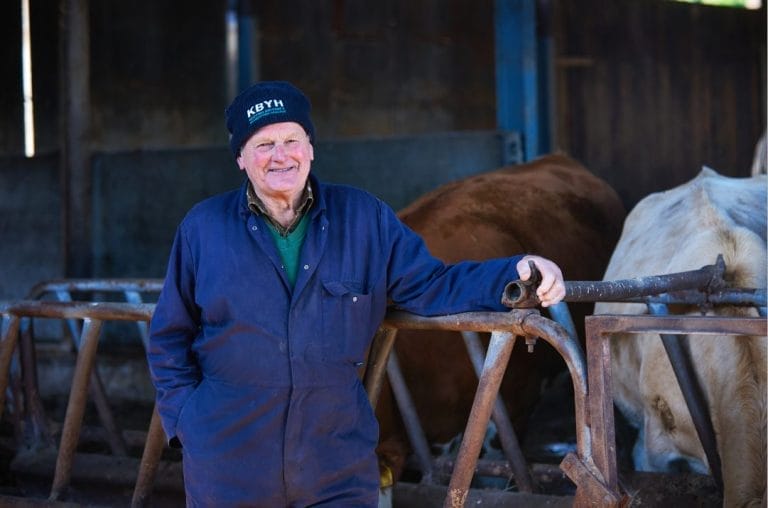
Nick Shadrick (left) with Paul Cholwill, Harpers Feeds.
Nick runs a herd of 70 cows averaging 9000 litres through a De Laval robot, but a second robot will be installed next year, and the herd size will increase to around 120. The cows graze in the summer and are fed big bales grass silage when housed. But for the last five years, maize has been an integral part of the system.
“While the cows were milking well, we thought they were capable of doing better,” comments Paul Cholwill from Harpers Feeds who advises Nick. “Milk ureas were high and so we decided the diet would benefit from more starch. As concentrates are only fed through the robot, maize silage was the obvious choice and would have rotational benefits but growing it would be a challenge.
“We had to plan for a short growing season as with heavy soils and plentiful rain we had to budget for possibly late drilling. We also needed it off early while we could still travel easily and not be left with a difficult harvest. This meant early varieties with good early vigour, but at the same time we need feed quality”
In the first year Nick grew 10 acres of Ambition as it met his criteria and he knew it grew well in the area. All field work is undertaken by local contractor F J Webber & Sons and the acreage has increased with an additional 12 acres grown on his son-in-law’s farm. As cow numbers increase, he will move to grow closer to 30 acres annually.
“We find maize fits our system well as it gives us an outlet for slurry,” Nick explains. “We don’t rush to drill, waiting until the soil has warmed up and we can work the ground down well. This year we didn’t drill until the second week in May but as we choose varieties with good early vigour, we know they will get away strongly, and by selecting early maturing varieties we can be confident of getting the crop off early most years. We have been growing continuous maize for four years.”
This year for the first time he grew the LG variety Pinnacle which is maturity class 9 (FAO 190) making it very early. He moved from Ambition on the recommendation of Paul Cholwill who emphasised the excellent ME yield and content coupled with a high starch yield in Pinnacle.
“The crop got away well and looked good all season. When we had the crop NIR tested, the indication was that it would be fit in early October, but we had to wait for the weather and eventually harvested a few weeks later and our contractor said it was the best crop he harvested this year, averaging 18 tonnes/acre.
“The maize has analysed well at 35.5% dry matter, 11.2 MJ/ME and 31.7% starch. We are feeding around 10kg maize per cow per day along with 20kg of baled grass and some molasses in the trough. Since going back on the maize, we have seen milk quality improve, we are averaging 30 litres per cow and the top cows are giving 50 litres plus.”
Paul Cholwill says Nick’s success demonstrates the benefit of selecting varieties carefully, taking account of the site class and growing conditions. “Maize is not the cheapest crop to grow but you can do a lot to maximise the return on investment and exploit the benefits it can bring.”


































